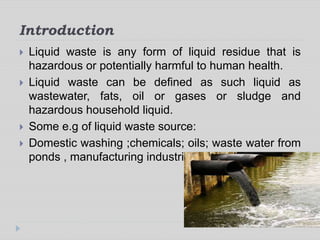An Unbiased View of Reclaim Waste
An Unbiased View of Reclaim Waste
Blog Article
Facts About Reclaim Waste Revealed
Table of Contents5 Easy Facts About Reclaim Waste ShownThe Reclaim Waste DiariesReclaim Waste - An OverviewThe Reclaim Waste IdeasThe Only Guide for Reclaim Waste
Explore the kinds, occurrences, and kinds of fluid waste. Domestic sewer waste refers to the waste and items from a residential septic tank. This kind of waste is developed by people in houses, institutions, and other buildings. This only consists of septic systems that have a drainpipe field. The correct administration and disposal of domestic sewer waste need liquid waste to be transferred to a sewer therapy plant where the proper approaches and equipment are used to cleanse and deal with waste.
Industrial waste often includes possible dangers, such as flammable materials or a combination of liquid and strong waste products, and calls for an advanced and detailed disposal process. The disposal of commercial waste typically involves the filtering of waste before transport to guarantee risk-free and correct disposal. Hazardous waste is produced from by-products and overflow of commercial procedures and manufacturing.
This type of waste can not utilize the very same sewage administration transport or processes as septic or business liquids. The hazardous waste administration process requires the examination and testing of fluid waste before it goes through the disposal procedure (liquid waste disposal melbourne). Drainage waste is the liquid waste that comes from runoff and excess stormwater in very booming locations or cities
Overflow waste can trigger contamination and flooding if not handled correctly. Making certain appropriate waste monitoring can avoid calamities and reduce ecological injury.
Our Reclaim Waste Statements
Get in touch with PROS Services today to find out regarding our waste management and disposal services and the correct ways to take care of the fluid waste you produce.
(https://www.edocr.com/v/pd6avrzq/leonaube33101/reclaim-waste)Do you know what happens to your water when you pull the plug, purge the bathroom or drain pipes the washing machine? No? Well, it deserves knowing. This supposed 'wastewater' is not just an essential resource yet, after treatment, will certainly be launched to our land, waterways or the sea. Used water from bathrooms, showers, bathrooms, kitchen area sinks, washings and industrial procedures is known as wastewater.

water utilized to cool down equipment or clean plant and tools). Stormwater, a form of wastewater, is overflow that moves from agricultural and metropolitan locations such as roofs, parks, gardens, roadways, courses and gutters into stormwater drains pipes, after rainfall. Stormwater flows without treatment straight to local creeks or rivers, ultimately getting to the sea.
The Greatest Guide To Reclaim Waste
In Queensland, a lot of wastewater is dealt with at sewer therapy plants. Wastewater is moved from domestic or commercial websites via a system of sewage systems and pump terminals, called sewage reticulation, to a sewer therapy plant. Regional governments develop, preserve and operate most sewer therapy plants. Operators are accredited under the Environmental Management Act 1994 to release cured wastewater at an acceptable ecological requirement into waterways.
The Division of Natural Resources encourages city governments about handling, operating and preserving sewerage systems and therapy plants. In unsewered locations, local governments might need householders to mount private or home sewage therapy systems to treat residential wastewater from bathrooms, kitchen areas, restrooms and washings. The Department of Natural Resources authorises using home systems when they are proven to be reliable.
In some new communities, treatment of some stormwater to eliminate litter, sand and crushed rock has actually begun using gross contaminant catches. Wastewater therapy occurs in 4 stages: Removes strong issue.
Wastewater then moves into big containers where solids settle and are eliminated as sludge. Oil and scum are skimmed from the surface. Makes use of tiny living organisms referred to as micro-organisms to damage down and remove staying liquified wastes and great particles. Micro-organisms and wastes are integrated in the sludge. Gets rid of nitrogen and phosphorus nutrients that can cause algal flowers in our rivers and intimidate aquatic life.
Getting My Reclaim Waste To Work
Nutrient removal is not available at all sewer therapy plants due to the fact that it calls for pricey specialized tools. It is ending up being a lot more typical in Queensland. Clear liquid effluent produced after therapy might still consist of disease-causing micro-organisms. If this effluent is released into rivers such as rivers or the sea, the micro-organisms will at some point die out.

This typically suggests wastewater needs to be treated or contaminants gotten rid of before it can be released to waterways. Most wastewater moves into the sewage system. Under the Act, city governments carry out approvals and licences for ecologically relevant tasks (ERAs) involving wastewater releases that may have a local influence. The department carries out approvals and permits to Ages entailing wastewater releases that could have a regional or statewide influence.
The Main Principles Of Reclaim Waste
Surveillance gives valid details concerning water top quality and can validate that permit conditions are being met. The information obtained via surveillance gives the basis for making water top quality choices.
Report this page